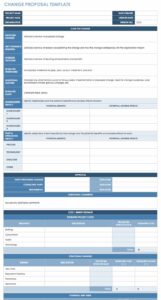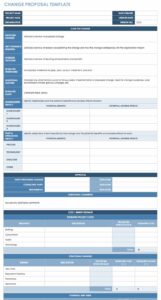Utilizing such a structure offers several key advantages. It minimizes miscommunication and misunderstandings by providing a standardized format for requesting adjustments. This, in turn, facilitates better decision-making by stakeholders and enhances the likelihood of project success. Furthermore, a formalized approach improves project control by documenting all change requests, creating an audit trail, and supporting more effective risk management.
This structured approach to managing alterations plays a vital role in maintaining project integrity and achieving desired outcomes. The following sections will explore the key components of these documents, best practices for their utilization, and strategies for integrating them into existing project management workflows.
Key Components of a Scope Change Request
Effective scope change management relies on a well-structured request process. Several key components ensure clarity and completeness, facilitating informed decision-making and minimizing potential disruptions.
1. Change Identifier: A unique number assigned to each request allows for easy tracking and referencing throughout the project lifecycle.
2. Request Date: Recording the submission date provides a clear timeline of when the change was initiated.
3. Requestor: Clearly identifies the individual or team submitting the change request.
4.. Current Scope Description: Briefly outlines the existing scope affected by the proposed change.
5. Proposed Change Description: Details the specific modifications being requested, including clear and concise explanations of the desired outcome.
6. Justification: Explains the rationale behind the change, highlighting the necessity and potential benefits.
7. Impact Assessment: Analyzes the potential effects of the change on project timeline, budget, resources, and quality. This includes an estimate of additional costs or time required.
8. Approval Section: Designated space for stakeholders to review and formally approve or reject the proposed change. This section typically includes space for signatures and dates.
These elements provide a standardized framework for documenting, assessing, and managing changes, promoting transparency and accountability throughout the project.
How to Create a Project Scope Change Request Template
Creating a standardized template ensures consistency and efficiency in managing project scope modifications. A well-defined template facilitates clear communication and provides a framework for thorough impact assessments.
1: Define the Header: Begin by establishing key identifying information. This includes fields for a unique change identifier, the date of the request, the requestor’s name and relevant contact information, and the project name or identifier.
2: Describe the Current Scope: Provide a concise summary of the existing project scope affected by the proposed change. This context helps stakeholders understand the implications of the modification.
3: Detail the Proposed Change: Clearly articulate the specific modifications requested. This section should outline the desired outcome, including what needs to be added, removed, or altered.
4: Justify the Change: Explain the rationale behind the requested modification. Clearly state the reasons for the change and its potential benefits to the project.
5: Assess the Impact: Analyze the potential effects on key project constraints. This includes evaluating potential impacts on the timeline, budget, resources, and overall project quality. Provide quantifiable estimates where possible.
6: Include an Approval Section: Designate space for relevant stakeholders to review and formally approve or reject the proposed change. This section should include space for signatures (digital or physical) and dates.
7: Version Control: Implement a version control system for the template itself. This ensures that the most up-to-date version is utilized and facilitates tracking changes to the template over time.
8: Training and Communication: Ensure all team members understand how to use the template correctly. Provide training and documentation to promote consistent application and maximize its effectiveness.
A well-designed template, coupled with consistent application and clear communication, contributes significantly to successful scope management and overall project success. Regularly reviewing and updating the template based on project needs and stakeholder feedback further enhances its efficacy.
Formalized documentation for requesting project modifications provides a critical mechanism for managing evolving project needs. From outlining clear change descriptions and justifications to assessing potential impacts on timelines and budgets, a structured approach ensures transparency, accountability, and informed decision-making. Leveraging standardized templates with key components like unique identifiers, impact assessments, and approval sections contributes significantly to minimizing disruptions and maintaining project integrity. Effective training and communication surrounding the utilization of these templates further empower teams to navigate change requests efficiently.
Ultimately, embracing a structured approach to scope change management fosters greater control over project outcomes. Consistent application of these principles equips organizations to adapt to evolving requirements while minimizing risks and maximizing the probability of project success. Proactive planning and diligent management of change requests remain crucial for navigating the complexities of modern projects and delivering desired results.


